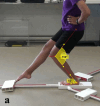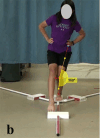Lower Extremity Kinematics of the Y-Balance Test in Healthy and ACL Injured Adolescent Females
- PMID: 33842034
- PMCID: PMC8016411
- DOI: 10.26603/001c.21529
Lower Extremity Kinematics of the Y-Balance Test in Healthy and ACL Injured Adolescent Females
Abstract
Background: Adolescent females are at significant risk for sustaining an ACL injury. The Y-Balance Test (YBT) is frequently used to evaluate neuromuscular control and lower extremity function. However, few studies have quantified 2D lower extremity kinematics during performance of the YBT, and there is an absence of kinematic data specific to at-risk adolescent females.
Purpose: To examine lower extremity joint kinematics during execution of the YBT by healthy and ACL-injured adolescent females.
Study design: Prospective cohort.
Methods: Twenty-five healthy and ten ACL-injured (mean time from injury 143 days) adolescent females were assessed using the YBT. Sagittal and frontal plane knee and ankle motion was video recorded during execution of the YBT anterior reach movement. Ankle dorsi-flexion, knee flexion, and knee valgus angles were quantified via kinematic analysis. ANOVAs with a post hoc Bonferroni correction were used to compare YBT scoring (%LL) and kinematic data between groups. Pearson product-moment correlations determined the relationship between kinematic data and YBT scoring.
Results: Healthy and ACL-injured subjects demonstrated similar YBT scores and lower extremity kinematic data. Healthy subjects demonstrated a weak positive correlation between ankle dorsiflexion and YBT scoring, and a weak negative correlation between knee valgus and YBT scoring. These relationships did not exist for ACL-injured subjects. Kinematic data for both groups also demonstrated a large degree of variability, regardless of YBT score.
Conclusions: Adolescent females frequently utilize a variety of lower extremity movement strategies when performing a functional movement task, and scoring on the YBT offers limited insight regarding lower extremity joint kinematics and ACL-injury risk in a physically active adolescent female population.
Level of evidence: Level 3.
Keywords: 2-dimensional video analysis; anterior cruciate ligament; dynamic balance; functional testing; movement system.
Conflict of interest statement
The authors declare that there is no conflict of interest.
Figures
References
-
- Incidence of anterior cruciate ligament tears and reconstruction: A 21-year population-based study. Sanders Thomas L., Maradit Kremers Hilal, Bryan Andrew J., Larson Dirk R., Dahm Diane L., Levy Bruce A., Stuart Michael J., Krych Aaron J. Jun;2016 Am J Sports Med. 44(6):1502–1507. doi: 10.1177/0363546516629944. - DOI - PubMed
-
- Sex differences in the incidence of anterior cruciate ligament, medial collateral ligament, and meniscal injuries in collegiate and high school sports: 2009-2010 through 2013-2014. Stanley Laura E., Kerr Zachary Y., Dompier Thomas P., Padua Darin A. Jun;2016 Am J Sports Med. 44(6):1565–1572. doi: 10.1177/0363546516630927. - DOI - PubMed
-
- Sport-specific yearly risk and incidence of anterior cruciate ligament tears in high school athletes: A systematic review and meta-analysis. Gornitzky Alex L., Lott Ariana, Yellin Joseph L., Fabricant Peter D., Lawrence J. Todd, Ganley Theodore J. Oct;2016 Am J Sports Med. 44(10):2716–2723. doi: 10.1177/0363546515617742. - DOI - PubMed
-
- Real-time assessment and neuromuscular training feedback techniques to prevent ACL injury in female athletes. Myer Gregory D., Brent Jensen L., Ford Kevin R., Hewett Timothy E. Jun 1;2011 Strength and conditioning journal. 33(3):21–35. doi: 10.1519/SSC.0b013e318213afa8. PMID: 21643474 PMCID: PMC3105897. - DOI - PMC - PubMed
-
- Biomechanical measures of neuromuscular control and valgus loading of the knee predict anterior cruciate ligament injury risk in female athletes: A prospective study. Hewett T. E., Myer G. D., Ford K. R., Heidt R. S., Colosimo A. J., McLean S. G., Bogert A. J., Paterno M. V., Succop P. Feb 8;2005 Am J Sports Med. 33(4):492–501. doi: 10.1177/0363546504269591. - DOI - PubMed
LinkOut - more resources
Full Text Sources
Other Literature Sources
Research Materials


